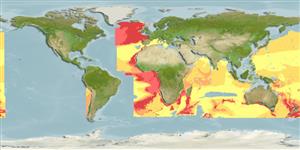Environment: milieu / climate zone / depth range / distribution range
Ecología
marino batipelágico; rango de profundidad 50 - 2500 m (Ref. 4774). Deep-water; 64°N - 51°S, 77°W - 174°W (Ref. 1371)
Eastern Atlantic: Iceland and Faeroes to Cape Bojador, West Africa, and including Azores, Madeira, and western Mediterranean. Also known from the Walvis and Vavilov ridges (Ref. 45011). Reported from Mauritania (Ref. 55783). Western Indian Ocean: in the region south of Madagascar. Pacific Ocean: temperate Australia, New Zealand, and between Valparaiso, Chile and the Juan Fernandez Islands.
Length at first maturity / Tamaño / Peso / Age
Maturity: Lm ?, range 34 - ? cm
Max length : 80.0 cm TL macho / no sexado; (Ref. 9563); common length : 45.0 cm TL macho / no sexado; (Ref. 9258)
Short description
Claves de identificación | Morfología | Morfometría
Espinas dorsales (total) : 0; Radios blandos dorsales (total) : 54 - 59; Espinas anales: 0; Radios blandos anales: 18 - 21. Eyes relatively large, greater than snout length in diameter. Anal fin originating near midlength of body, deeply indented at midlength, sometimes appearing as two. Ventral light organ absent. Color is generally gray.
Recorded from the upper continental slope (Ref. 9563). Occasionally found at 50 m. Feeds on fishes, crustaceans, mollusks and other invertebrates as well as food of terrestrial origin, including garbage. Probably a winter and early spring spawner (Ref . 4774). Minimum depth from Ref. 106682.
Cohen, D.M., T. Inada, T. Iwamoto and N. Scialabba, 1990. FAO species catalogue. Vol. 10. Gadiform fishes of the world (Order Gadiformes). An annotated and illustrated catalogue of cods, hakes, grenadiers and other gadiform fishes known to date. FAO Fish. Synop. 125(10). Rome: FAO. 442 p. (Ref. 1371)
IUCN Red List Status (Ref. 130435: Version 2024-1)
Threat to humans
Harmless
Human uses
Pesquerías: escaso valor comercial
Herramientas
Special reports
Download XML
Fuentes de Internet
Estimates based on models
Preferred temperature (Ref.
123201): 3.2 - 8.9, mean 5 °C (based on 1437 cells).
Phylogenetic diversity index (Ref.
82804): PD
50 = 1.0000 [Uniqueness, from 0.5 = low to 2.0 = high].
Bayesian length-weight: a=0.00603 (0.00451 - 0.00805), b=3.15 (3.07 - 3.23), in cm total length, based on LWR estimates for this species (Ref.
93245).
Nivel trófico (Ref.
69278): 3.8 ±0.55 se; based on food items.
Resiliencia (Ref.
120179): Bajo, población duplicada en un tiempo mínimo de 4.5-14 años (Assuming tm>4).
Fishing Vulnerability (Ref.
59153): High to very high vulnerability (69 of 100).
Climate Vulnerability (Ref.
125649): Moderate vulnerability (38 of 100).
Nutrients (Ref.
124155): Calcium = 17.7 [5.5, 46.7] mg/100g; Iron = 0.283 [0.126, 0.817] mg/100g; Protein = 18.4 [16.5, 20.1] %; Omega3 = 0.184 [0.071, 0.470] g/100g; Selenium = 21.7 [7.4, 57.4] μg/100g; VitaminA = 18 [2, 134] μg/100g; Zinc = 0.439 [0.244, 0.868] mg/100g (wet weight); based on
nutrient studies.
